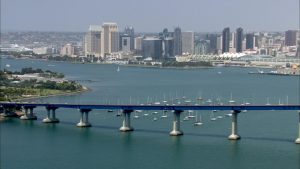San Diego Spring Weather explained
Everyone thinks San Diego weather is 70 degrees and sunny all the time. I have learned the hard way not to even mention the weather when talking with relatives in the Midwest. In particular, they have commented on the Southern California weather phenomenon known as May Gray and June Gloom, and how surprised they were that the ocean water in Southern California is so cold, even well into the summer months. With all the association of Southern California with surfing and water sports, they figured that the water was quite warm, and that the weather, particularly in San Diego, was perfect year round.
Its not.
I walked outside a little while ago and noticed that, for the first time in over a week, the San Diego weather is not “May Gray.” This is a very pleasant change to this astronomer, who likes to see the little white twinkly things at night before bed.

So, why am I writing about cold water and clear skies in the same blog post? Because they’re related.
Like what you’re reading? Get more like this by joining the email newsletter now
[yikes-mailchimp form=”1″]
The reason why the coastal areas of Southern California have “May Gray” and “June Gloom” has to do with chemistry. There, I said it. You will have to learn a little science in the process of this page. I promise to keep it simple. Water has a specific heat of 4.184 Joules per gram degree Celsius. I wrote it all out, so you wouldn’t get lost in mathematical symbols. I wrote it just like chemists and physicists say it.
What that means is that water does not change its temperature easily. By comparison, metals have specific heats of less than 1, and many have specific heats less than 0.5. That is why metals are called excellent CONDUCTORS of heat. They allow heat to flow easily within them. Water, on the other hand, not so much.
So, what’s astronomy got to do with it?
After the Earth passes vernal equinox on the First Day of Spring, around March 20th every year, the Northern Hemisphere is pointing towards the Sun, and gets more sunlight. The amount of sunlight the Northern Hemisphere gets peaks on Summer Solstice, around June 20th. The extra sunlight causes the air temperature to increase, and it does so pretty easily. The water temperature, though, remains cold. Its like the old joke about how many psychologists does it take to change a light bulb? Only one, but it has to WANT to change. Water does not WANT to change. The air is warm, the water is cold. And that temperature difference causes May Gray and June Gloom. It causes the air to be cloudy and “hang” over the coastal areas, well into early afternoon, clearing off for a bit usually, then moving back in around 5 or 6 pm.

As the summer progresses, and Earth gets closer and closer to summer solstice, the water temperature EVENTUALLY warms up, and the May Gray and June Gloom usually goes away. In July and August, Southern California usually enjoys the clear skies and warm water we are famous for, and San Diego weather attracts legions of tourists to its temperate climate, while others are roasting are freezing.
[yikes-mailchimp form=”1″]
Now you know why Southern California, in particular San Diego, weather is the way that it is, and why the skies are so clear in January and February, when the rest of the country is freezing. It is because the water and air temperature are close to the same.